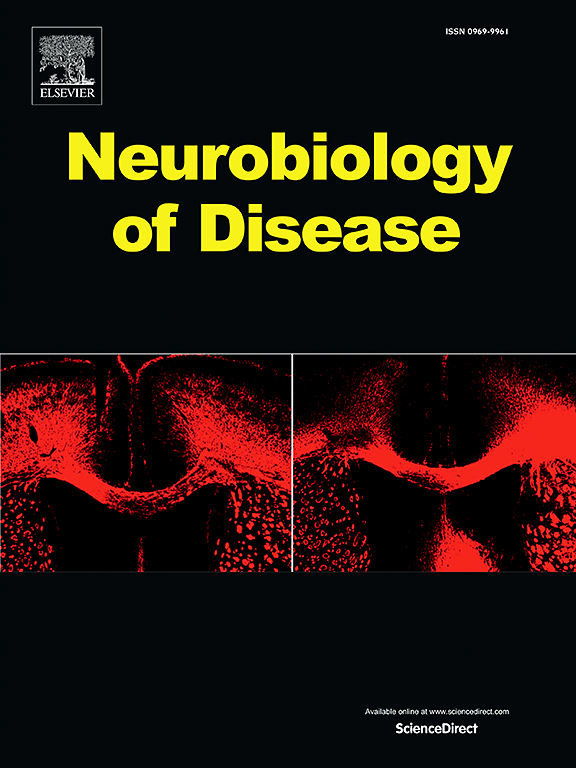Age-related cerebral amyloid angiopathy accumulation in the APPSw mouse model is associated with perivascular inflammation and brain-wide vascular and inflammatory gene and protein changes
IF 5.6
2区 医学
Q1 NEUROSCIENCES
引用次数: 0
Abstract
Cerebral amyloid angiopathy (CAA) is an extremely common pathology of Alzheimer's disease (AD) included under vascular contributions to cognitive impairment and dementia (VCID). CAA has been reported in 78–98 % of AD cases and has clinical significance when considering side effects that arise when using amyloid targeting immunotherapies. Despite its prevalence, studies addressing CAA mechanisms have been scarce and there are clear gaps in our understanding of how CAA progresses. This study uses Tg2576 mice, who develop CAA over time, to establish a time course of CAA progression at 8-, 14-, and 20-months of age. We identify changes in transcriptomic signatures of glial cells using NanoString nCounter and targeted protein changes using NanoString Digital Spatial Profiling. Meso Scale Discovery and immunohistochemistry are used to establish disease progression. In this study, we saw many changes primarily associated with inflammatory response, with some changes being transient (Tnf, Lsr; VEGF) and others remaining chronically altered (Osmr, Ccl3; CTSD). Overarchingly, many of these changes relate to the perpetuation of inflammation or recruiting additional immune support, which we see across our timepoints. Further, we identified differences in abundance of proteins (CD45, GFAP, CD31) based on presence of CAA positive vessels within a brain region. We also identified sex-specific differences in CAA burden, as well as how glial reactivity and vessel density change during disease progression. This data represents a comprehensive analysis of CAA progression and differential responses to parenchymal and vascular amyloid that could inform future basic and clinical studies.
在APPSw小鼠模型中,年龄相关性脑淀粉样血管病的积累与血管周围炎症和全脑血管和炎症基因和蛋白质的变化有关
脑淀粉样血管病(CAA)是阿尔茨海默病(AD)的一种极其常见的病理,包括血管对认知障碍和痴呆(VCID)的贡献。CAA在78 - 98%的AD病例中有报道,在考虑使用淀粉样蛋白靶向免疫疗法时产生的副作用时具有临床意义。尽管它很流行,但关于CAA机制的研究很少,而且我们对CAA如何进展的理解也存在明显的差距。本研究使用Tg2576小鼠,随着时间的推移发生CAA,建立8、14和20月龄时CAA进展的时间过程。我们使用NanoString nCounter识别神经胶质细胞转录组特征的变化,并使用NanoString数字空间分析识别靶向蛋白的变化。中观尺度发现和免疫组织化学用于确定疾病进展。在这项研究中,我们发现许多变化主要与炎症反应相关,有些变化是短暂的(Tnf, Lsr;VEGF)和其他慢性改变(Osmr, Ccl3;CTSD)。总的来说,这些变化中的许多与炎症的延续或招募额外的免疫支持有关,这是我们在不同的时间点上看到的。此外,我们根据脑区域内CAA阳性血管的存在确定了蛋白质(CD45, GFAP, CD31)丰度的差异。我们还确定了CAA负担的性别特异性差异,以及胶质反应性和血管密度在疾病进展过程中的变化。该数据代表了CAA进展和对实质和血管淀粉样蛋白的差异反应的全面分析,可以为未来的基础和临床研究提供信息。
本文章由计算机程序翻译,如有差异,请以英文原文为准。
求助全文
约1分钟内获得全文
求助全文
来源期刊

Neurobiology of Disease
医学-神经科学
CiteScore
11.20
自引率
3.30%
发文量
270
审稿时长
76 days
期刊介绍:
Neurobiology of Disease is a major international journal at the interface between basic and clinical neuroscience. The journal provides a forum for the publication of top quality research papers on: molecular and cellular definitions of disease mechanisms, the neural systems and underpinning behavioral disorders, the genetics of inherited neurological and psychiatric diseases, nervous system aging, and findings relevant to the development of new therapies.
 求助内容:
求助内容: 应助结果提醒方式:
应助结果提醒方式:


